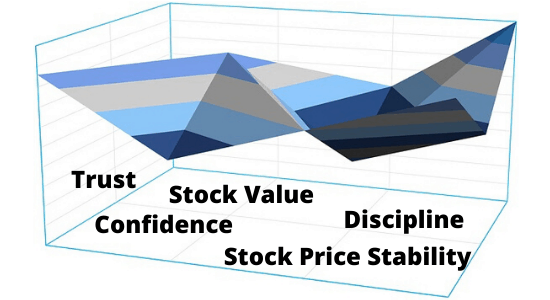12 Companies That Know The Importance of Dividend Policy
The importance of dividend policy is critical when investing in a stock.

Why is that? I won’t buy a stock unless it pays a dividend.
Certainly, not every investor agrees with my investment approach. But, a recurring dividend is my first investment criteria before I consider investing in a stock.
Importance Of Dividend Policy
So today, I want to discuss the importance of dividend policy.
Along the way, we will answer a few questions. Questions like:
- What is dividend policy?
- Why is dividend policy important?
- Does a company’s dividend policy affect its stock price?
- What are some examples of dividend policies?
Knowing a little about dividend policy is part of understanding how stock dividends work. Let’s delay no longer and dig in…
What Is A Dividend?
Dividends are payments made by a company to owners of the company’s stock. They can be in the form of cash, additional shares of stock, or property.
It is important to note, that companies are not required to pay dividends. And, each dividend payment must be approved in advance by the company’s board of directors.
Most dividends are paid in the form of cash. Cash dividends are the focus here at Dividends Diversify. And, today’s article about the importance of dividend policy is no exception.
What Is Dividend Policy?
Dividend policy comes from one or more dividend theories. That form a company’s specific view about dividends.
As I mentioned, each dividend payment must be authorized by a company’s board of directors. So, does the board just get together and say hey “let’s pay everybody a dividend today”?
Most likely, the answer to that question is no. More typically, the company’s board has established a dividend policy and distribution guidelines.
First of all, a dividend policy sets the parameters for delivering dividends to shareholders.
Furthermore, dividend policy covers the type of dividend distribution, its frequency, and timing.
Finally, the dividend policy must be determined in context with other financial needs of a business.
Dividend policy is very important to me. Why? It determines how much cash I will receive as a shareholder and when. Knowing this is important when you live off your dividend payments.
Factors Affecting Dividend Policy

Management, working with the board of directors, must determine the best uses for a company’s cash. From a high level, a company has 2 options for its cash:
- Retain it
- Pay it to shareholders
If they decide to retain it, they have several more options to consider. Specifically, they can
- Increase cash reserves or other liquid investments
- Reinvest back into the business
- Acquire another company
- Pay off debt
- Buyback shares of their stock
All of these competing options for the use of cash are factors affecting dividend policy.
For example, a company may have large amounts of debt. Furthermore, its debt agreements may limit the dividends it can pay.
That is just one example of a specific factor affecting dividend payments. There are many more.
But, that is an article for the future. So, I will put an article about factors determining dividend policy on my to-do list for another day.
Every Company Has A Dividend Policy
Regardless, of what they decide to do with their cash, every company has a dividend policy. The dividend policy may not be formalized. Furthermore, it may never be communicated internally or externally.
But whether a company chooses not to pay a dividend. Or, they choose to pay dividends in the same months every year. They have a dividend policy.
Here are several examples. I do not own Amazon or York Water. And, I have no idea if they have formally communicated a dividend policy. But, I know they have one by their actions.
Amazon’s Dividend Policy
Amazon (NASDAQ: AMZN) has never paid a dividend during its history. I’m not sure if there has been any formal communication about the lack of dividend payments. Or, what the future may hold for dividends from Amazon.
But, I need no communication. Amazon’s dividend policy based on its actions is that they do not pay dividends.
York Water’s Dividend Policy
On the other extreme, York Water (NASDAQ: YORW) has paid dividends each year for more than 200 years. Based on their history, I conclude that an investor in York will receive dividends every year.
One more example from a company whose stock I do own. That stock being IBM.
IBM’s Dividend Policy
To my knowledge, IBM has not formally communicated specific details about its dividend policy. But, I have seen elements of dividend policy when I read other communications from the company.
In past press releases, IBM has used key phrases. For example, “support a solid and growing dividend” and “fully committed to our dividend”.
These phrases help me understand IBM’s dividend policy. Feel free to read more about IBM and IBM’s dividend policy. It is an interesting study.
Why Dividend Policy Is Important

So, let me conclude. If every company has a dividend policy, then a dividend policy must be important.
Here’s an analogy. If everyone wears clothes in public, then wearing clothes in public must be important. And it is! No one has to formally communicate this to me or you.
Wearing clothes in public is important and we know it. Just like a dividend policy.
But, the importance of a dividend policy is bigger than that. Because I like finding stocks with good dividends. Here are a few reasons why dividend policy is important.
Dividend Policy Provides Information To Investors
Dividend policy is important because it outlines the amount, method, type, and frequency of dividend distributions. This is true whether the dividend policy is formally stated. Or, informally implied.
One of the objectives of dividend policy is to send signals to current investors and attract new investors. Sound dividend policy tells an investor what they can expect by investing in a company’s shares of stock.
Also, every time a dividend is declared, it shows management’s confidence in the prospects for the business.
A sound dividend policy builds trust and provides investors with confidence in their investment. It suggests the company is solid, stable, well-managed, and profitable. It encourages ownership by long-term investors not traders.
Some investors, like me, won’t invest in a stock if it doesn’t pay a dividend. Certain mutual funds and exchange-traded funds (ETFs) will not invest in stocks that do not pay a dividend. Many large scale institutional investors and activist investors demand a suitable dividend policy.
Dividend Policy Encourages Management Discipline
Having a dividend policy that requires payment of a regular dividend sets a level of discipline that management must follow with the use of cash.
They know that all cash is not available for reinvestment in the business or acquisitions. So they must choose carefully when they allocate cash.
Dividend Policy Influences Stock Price And Value

Critics say that dividend policy is irrelevant. As it relates to a stock’s price.
They say a company should retain and reinvest its profits. To drive the stock price up. Then investors can make homemade dividends from the paper profits.
But, I don’t believe in this argument. Here’s why.
In my opinion, dividend policy has a positive influence on the value of a company’s stock. Here are several reasons why I believe this to be true.
First of all, some stock valuation methods are entirely based on the present and projected dividends paid by the company.
One such method is commonly known as the dividend discount model or the Gordon Model. It is named after economist Myron J. Gordon.
I frequently use the dividend discount model. It is a tool for assessing the value of dividend stocks that I cover for you here at Dividends Diversify.
The dividend discount model uses the recurring dividend payment today and the expected growth of the dividend in the future. The greater each is, the more a company’s stock is worth today.
Furthermore, a reliable and recurring dividend payment policy supports the stock price. This is especially true during times when stocks and the stock market are going down.
A falling stock price means a rising dividend yield. All else being equal a rising dividend yield attracts investors and provides underlying support for the stock price.
Finally, many institutional investors and dividend funds will only own the stock of a company if it pays a dividend. These types of investors and investments also provide a floor for a stock’s price.
Types Of Dividend Policies
Dividend policies fall into 1 or a combination of several different methods. Let’s go through each type of dividend policy next.
The descriptions are pretty logical. So, I will try to keep my explanations brief.
Regular Dividend Policy
As the name suggests, a company with a regular dividend policy pays dividends on a consistent and predictable basis.
Most likely, payments are made each quarter, twice a year, or annually. Some pay dividends monthly.
A regular dividend is determined in one of 3 ways.
Constant Dollar
With a constant dollar dividend policy, the company decides a fixed amount of dividend per share for the stockholders. Then, the dividend is paid on a consistent and periodic basis during the year. Sometimes this method is also referred to as a stable dividend policy.
Usually, there is no change in the dividend. This is true even if the company incurs a loss or generates a higher than expected profit.
As the name suggests, the dividend stays a constant dollar amount per share. This provides investors confidence about the future value and timing of dividend payments they will receive.
First of all, many U.S. based companies have a constant dollar dividend policy. Furthermore, this dividend policy is very helpful when determining the value of a stock using a dividend valuation model. Finally, I like to fill my dividend portfolio with companies that use a constant dollar dividend policy.
Constant Payout Ratio
In the case of a constant payout ratio, dividends are distributed to shareholders based on a specific portion of the company’s earnings or cash flow.
The dividend distribution amount is directly proportional to the company’s earnings. This method makes internal financing decisions from earnings or cash flow much easier.
On the other hand, an investor has less certainty about the dividends they will receive. Since profits and cash flow will never be the same from year-to-year.
Hopefully, the dividend grows each year. But, that is not guaranteed. Finally, many non-U.S. based companies use the constant payout ratio dividend policy.
Residual Payout
A residual dividend payout policy means dividends are distributed from profits but only after all other necessary capital outlays are accounted for.
It’s truly the money left over in the business. That is, after retaining the money necessary for internal investment.
So, whatever money is left, the company pays shareholders dividends. Similar to the constant payout ratio, an investor does not know how much cash they will receive.
Irregular Dividend Policy
As the name implies, irregular dividends are paid on no particular schedule or amount. Irregular dividends are most typical in businesses that have unpredictable demand for their products and services.
Business unpredictability does not allow company management to commit to regular dividend policy or stable dividend policy.
Regular Dividend & Extra Irregular Dividend Payments
In some cases a company’s dividend policy will combine elements of both regular and irregular policies. As an income investor, this is the best of both worlds.
You can count on a company’s regular and recurring dividends. And when business is going well, you can hope for an extra payment from the profits and cash flows of the business.
No Dividends
Some companies do not pay dividends. Not paying dividend is their dividend policy.
They simply do not have the cash to afford dividend payments. Or, choose to retain all profits in the business, like our Amazon example.
Sound Dividend Policy And The Business Life Cycle
A company’s dividend policy often indicates its stage in the business life cycle. In the best case, the nature of dividend policy is in sync with where a business is in its life cycle.
Here are typical dividend policies associated with business life cycle stages.
Start-Up – A no dividend policy. All cash retained for internal investment and growth initiatives.
Growth – A no dividend policy during the early stages of rapid growth. Management may consider an irregular dividend or constant dividend at a low rate as growth slows.
Maturity – A regular dividend policy that shares a large portion of earnings with investors in the form of dividends.
Decline – Many companies can continue to reinvent themselves. They can reside permanently in the maturity phase.
A company like Abbott Labs (NYSE: ABT) is a perfect example. Abbott has nearly 150 years of operating history. And, continues paying dividends without ever going into decline.
On the other hand, some companies enter an unavoidable state of decline. Companies in decline rarely pay dividends. Or, if they do, their dividends may be at risk of a future reduction.
One exception I see here is tobacco. Companies in the tobacco industry are working hard to reinvent themselves. Mainly by introducing smokeless products. They are doing so to avoid the inevitable decline in cigarette smoking.
So, by looking at a company’s life cycle stage, it easier to determine what an optimal dividend policy for the company should look like.
Dividend Policy Statements
Not all companies formally communicate their dividend policies. But I sure like the clear communication. As I said, a dividend policy statement sends signals to us investors.
It is significant and important.. So when I can, I communicate their dividend policy to you!
Furthermore, when I analyze a dividend stock, I always look to see if the company has stated its dividend policy. Because it helps me forecast future dividend payments.
What follows are some of the important dividend policy statements I found for the holdings in the Dividends Diversify model portfolio.
These statements are not always easy to find. They come from a variety of sources on company investor relations websites.
Where and how dividend policy is communicated depends on the company. As I said, it may not be communicated to the public in any form.
This is unlike communicating financial statement information. For public companies, financial statement information following accounting principles must be communicated to the public on a timely schedule.
Sources For Dividend Policy Statements
First of all, I’ve found that the most typical sources for dividend policy statements are:
- Press releases announcing increasing dividend payments
- Press releases announcing quarterly earnings
- Strategic plan documents
- Investor presentations
- Presentations at industry conferences
- Annual shareholder meeting presentations
Furthermore, these high profile communication methods emphasize the importance of dividend policy.
Finally, by looking at a range of specific company examples we will more clearly see different elements of dividend policy.
For example, the companies I invest in typically employ a regular dividend policy using the constant dollar dividend policy. As a reminder, this is also known as a stable dividend policy.
Investors know this based on the company’s dividend payment history. So, the company’s dividend policy communications often focus on future dividend increases or dividend growth objectives.
Here’s my list of 12 companies that know the importance of dividend policy. And, share their dividend policy with the public.
Most of these firms are examples of US dividend growth companies. Excellent for use in building a dividend income portfolio.
But first, a few thoughts and conclusions. Then onto the specifics of these companies and their dividend policies.
12 Company Examples Of Dividend Policy Statements
Judging from this non-scientific sample, utility companies are some of the best when it comes to communicating dividend policy.
In contrast, I noticed none of my health care sector stocks made the list. But that doesn’t bother me.
Why not? Just because a company does not formally communicate a dividend policy does not mean it isn’t a good dividend stock for your investment dollars.
For example, the technology company Microsoft comes to mind immediately. It is one of the few remaining companies with a AAA credit rating. And has built a nice history of annual dividend increases for its shareholders.
Also, some companies communicate a more global return of capital strategy. It may include combined targets for dividends and stock repurchases. Cummins is an example of a company that does this.
Here’s the list…
NextEra Energy

“The NextEra (NYSE: NEE) board approved an updated dividend policy for beyond 2020. It is expected to translate to a growth rate in dividends per share of roughly 10% per year through at least 2022. The growth is off the 2020 base dividend.”
Dominion Energy
Dominion Energy (NYSE: D) now expects to target an approximately 65 percent payout ratio. After the sale of its gas storage and transmission business to Berkshire Hathaway.
According to the company, “the … annual dividend reflects the absence of income from the divested natural gas assets and a revision to the company’s target payout ratio to align with best-in-class utility industry peers”.
Looking forward, the company expects annual dividend-per-share increases of approximately 6 percent per year. This represents a significant increase from the previous long-term dividend per-share growth guidance of 2.5 percent.
Kimberly Clark

The Kimberly Clark (NYSE: KMB) strategic plan states that future dividend growth will approximate earnings per share growth.
AT&T
The giant telecommunications company, AT&T plans for “continued modest annual increases; dividends as % of free cash flow to be less than 50% range in 2022.”
AEP
American Electric Power communicates in its recent investor presentation materials that they expect earnings to grow 5-7% annually. And they intend to increase the dividend each year at a similar rate.
ADP
According to their recent investor presentation, the payroll processing company, ADP is targeting a 55% – 60% dividend payout ratio.
Emerson
Emerson (NYSE: EMR) has a dividend policy. It is part of their overall 5-year capital allocation plan.
Management’s goal is to make dividend payments to shareholders equating to approximately 37% of free cash flow.
Duke Energy
Duke Energy (DUK) states its objective is to increase the dividend 4-6% annually through 2023. This corresponds directly with projected annual earnings growth.
Norfolk Southern
Norfolk Southern (NYSE: NSC) has a goal to payout 33% of accounting earnings in the form of dividends.
Altria

Altria, the maker of Marlboro cigarettes, states in a recent press release that their dividend payout ratio target is approximately 80% of adjusted diluted earnings per share.
Coca-Cola

Coke’s management intends to grow the dividend as a function of free cash flow, with a 75% payout ratio over time.
In the cola wars, advantage Coke. Why? Pepsi does not communicate its dividend policy. But I know Pepsi has one.
Wisconsin Energy Group (WEC)
Management provides the following guidance on the WEC dividend growth rate:
- Continuing to target dividend payout of 65-70 percent of earnings
- Projecting dividend growth in line with earnings growth
Importance of Dividend Policy Wrap Up
So, is dividend policy irrelevant? I’d say no. It is very relevant.
Dividend policy is important because it outlines the amount, method, type, and frequency of dividend distributions.
Other reasons that sound dividend policy is important include:
- Builds trust with existing investors
- Attracts new investors
- Encourages investment from long-term investors, not traders
- Projects confidence about the future from management
- Instills capital allocation discipline in company management
- Provides information for stock valuation
- Provides underlying stability to the stock price
Not all companies formally communicate their dividend policy. But every company has one.
From a dividend investor’s perspective, it is a big advantage when a company is clear and transparent about its plans for the dividend.
Further Reading About Dividend Investing
- Book review: The Little Book Of Big Dividends
- Dividend stock recommendations from Simply Investing
- Utility Forecaster investment newsletter review
Author Bio: Tom Scott founded the consulting and coaching firm Dividends Diversify, LLC. He leverages his expertise and decades of experience in goal setting, relocation assistance, and investing for long-term wealth to help clients reach their full potential.
Hi Tom,
I like what you say about companies in decline not paying dividends. I’m not a corporate lawyer, but I kind of remember hearing something like this in my corporations class. I take regular dividends as a sign of strength, which makes it more likely I’ll invest in a company.
Cheers,
Miguel
Well said, Miguel. Thanks! Tom
Great post, loved the cool illustration.
I like dividend paying companies too, it sort of feels like they are more accountable to their shareholders.
That being said, something like Berkshire Hathaway has never paid a dividend and Warren Buffett is very accountable his shareholders and communicates well and has integrity. Do you have BRK in your portfolio?
Hi GYM. I do not have BRK. Rightly or wrongly, I only invest in stocks and other securities that pay dividends or interest. Tom